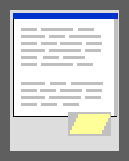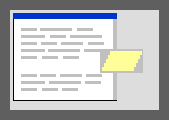 |
TM |
| Home | |
| Why AlphaTap? | |
| Lightning | |
| Download & Licensing | |
| User Guide | |
| Tech Notes | |
| Email Us | |
User Guide
When using AlphaTap, you rest your hand in one place on the screen. The 4x7 "staircase" layout lets you type with the range of motion typical of handwriting. At rest your pen should hover over the intersection of the R, I, and space keys.Over 250 common English words can be stroked using AlphaTap's Lightning shorthand. Stroked words and fragments can be produced rapidly and with ease. Learning the Lightning vocabulary is easy, because AlphaTap highlights affected keys around the currently pressed key so you can step through a word slowly until you learn its path. The Practice Game (see the ► menu) walks you through the vocabulary and scores your performance. Example phrases & more on Lightning
Use a light touch with the pen! It's a sensitive instrument, and pressing hard will give you less control and more fatigue. Some tablets occasionally produce two taps when only one was intended. With AlphaTap this causes two key presses.
When starting a stroke the pen point must travel a minimum distance on the screen to register the second key. This prevents accidental inputs from the sliding common when tapping the screen. Function and control keys cannot be stroked in the default configuration to minimize the possibility of hitting them accidentally when stroking regular keys.
A left-handed layout is accessible under Layouts on the ► menu. Note: these guidelines are for right-handed use; we'd appreciate any tips that apply to left-handed use.
Once you've saved the download on your tablet, simply open the .Zip file and drag the AlphaTap folder out of it. You can deposit it anywhere you like. The link !BEFORE YOU START describes how to turn off "press & hold", which is helpful. Then launch AlphaTap by double-tapping AlphaTap.exe. (There's no installer to run!) We recommend that you set AlphaTap to run on startup by choosing Auto Start from the ► menu on the layout.
Calibration of the pen is important for accurate tapping and stroking. The crosshair cursor over the AlphaTap keys should fall just slightly northwest of the pen tip. When calibrating, place the tablet on a stable flat surface and hold the pen as you would for normal use. Tap each corner target just slightly southeast of its center point. Repeat if necessary, adjusting the offset you use on the corner targets.
Upgrading to Standard from Lite or previous versions:
Before launching the new version,
quit the installed version by right-tapping the  icon
in the task bar and selecting Quit AlphaTap.
If you have recorded any phrases, copy alphatap.phrs
to the AlphaTap 1.7 folder.
If you have added any shorthand words to userd.txt,
copy this file to the AlphaTap 1.7 folder.
After launching the new version, check the ► menu;
if it contains the option User Start, select this option, then reopen the menu
and select Auto Start.
icon
in the task bar and selecting Quit AlphaTap.
If you have recorded any phrases, copy alphatap.phrs
to the AlphaTap 1.7 folder.
If you have added any shorthand words to userd.txt,
copy this file to the AlphaTap 1.7 folder.
After launching the new version, check the ► menu;
if it contains the option User Start, select this option, then reopen the menu
and select Auto Start.
Positioning AlphaTap on the Screen
To move the AlphaTap window drag it by its translucent background.
The ideal positioning of the key layout would be directly beneath the current text entry point,
however that would require either the layout to be in constant motion,
or the app to constantly shift its content.
Having the app situate the current entry line right above the key layout is a better strategy.
 But until apps become AlphaTap-aware you need to pick the best placement.
The key is placing the layout close to the entry point and
keeping your hand from covering the text area.
But until apps become AlphaTap-aware you need to pick the best placement.
The key is placing the layout close to the entry point and
keeping your hand from covering the text area.
In portrait mode (the preferred mode for AlphaTap) this can be accomplished by placing the AlphaTap window at the bottom right of the screen and sizing the app window to sit just above it. Leave enough room to rest your hand on the tablet below and to the right of the window.
 In landscape mode you can use the same approach as portrait,
or compromise for more app area by placing the AlphaTap window on the right side
of the screen overlapping the app window and as far up
as required for your hand to rest on the lower right corner of the tablet.
Size the app window so that you can see almost all of it with your hand resting
on the tablet.
In landscape mode you can use the same approach as portrait,
or compromise for more app area by placing the AlphaTap window on the right side
of the screen overlapping the app window and as far up
as required for your hand to rest on the lower right corner of the tablet.
Size the app window so that you can see almost all of it with your hand resting
on the tablet.
The default AlphaTap layout size is designed for a ten-inch display at 1024x768 resolution. When using a tablet of different size (e.g. a desktop pen tablet), the layout should be enlarged (for a smaller surface) or reduced (for a larger surface) by adjusting the KeyStyle height, width, and font sizes in the alphatap.xml file. A future release will enable resizing from the AlphaTap menu.
Special Key Labels
|
ɛ ▹ ◁ × ↵ ⊥ ⇦⇨⇧⇩ |
escape delete backspace enter / carriage return tab (inverted T) arrows |
⇐⇒ ⇑⇓ ⊞ ≡ ↴ ⊡ |
home & end page up & page down windows shift key context menu key insert (numeric pad) printscreen (numeric pad) |
Lightning Shorthand Details
The ↯ key on the top left of the layout toggles on and off Lightning mode. When toggled on, the backspace key (◁) erases an entire stroke, for up to five previous strokes. To delete other text the delete key should be used. (This feature can be disabled within the alphatap.xml file.)
The Practice Game option on the ► menu enters the practice mode. The game opens a guide in a browser window (or prompts you to open the practice.html file if it can't open a browser). When you get comfortable with the vocabulary, test your performance by toggling caps lock for normal key highlighting, and using one word repetition. A skilled user can exceed fifty strokes per minute.
The Lightning vocabulary is defined by the alphatapd.txt file.
The vocabulary is user-extensible, by adding words to the userd.txt file.
After modifying userd.txt, right-click the  icon
in the system tray and select Reload Layouts.
Since these files may contain more words than can be mapped onto the layout,
AlphaTap reports any unmapped words in its Dictionary Stats
(on the ► menu) along with the
count and combined frequency of the mapped words.
icon
in the system tray and select Reload Layouts.
Since these files may contain more words than can be mapped onto the layout,
AlphaTap reports any unmapped words in its Dictionary Stats
(on the ► menu) along with the
count and combined frequency of the mapped words.
Phrase Recording and Playback
The phrs key on the top row allows keystroke sequences to be recorded and played back at any time. When phrase mode is toggled on, keys with assigned phrases highlight, and the contents of a key's phrase display in a popup label when the pen is over the key. In phrase mode, you have the following options:
| - | To play back a phrase into the current window, tap its highlighted key. |
| - | To record a new phrase, tap any unhighlighted key (phrs key highlights red); the new phrase will be assigned to that key. When done recording, tap the phrs key to exit recording mode. |
| - | To give a custom label to an assigned key, type the label text into an editor (e.g. MS Word) and copy it to the clipboard, then tap the ≡ key (lower left on layout) while in phrase mode (it highlights red), then tap the highlighted key to be relabeled. |
| - | To delete a recorded phrase, tap the backspace key while in phrase mode (backspace highlights red), then tap the highlighted key whose phrase should be deleted. |
| - | To exit phrase mode without performing any of the above options, tap the phrs key. |
Note: AlphaTap Lite only provides playback of pre-installed key sequences, without the record, label and delete functions.
Generating Accented & Extended Characters
The a↓ toggle key at top left makes the alt key a locking key, and switches the number keys' output to numeric keypad codes when alt is locked. This allows use of alt n n n n alt to produce a variety of non-English characters, e.g. alt 0 2 2 0 alt yields Ü. The Windows Character Map utility describes the alt sequence for those characters that have one.
Layout Controls
At top right on the layout:
± Toggles the numeric keypad
F Toggles the function key group
S Toggles the symbol key group
► Opens the AlphaTap menu:
|
About AlphaTap: displays the info box. Auto Start: installs a link to the AlphaTap program in the user startup folder so that it starts when you log into the tablet. Practice Game: starts the Lightning Shorthand practice game. Dictionary Stats: reports results of reading the dictionary files. Layouts: selection of other key layouts installed in AlphaTap or via your alphatap.xml file. |
 Hides window; to reopen it, tap the tray icon.
Hides window; to reopen it, tap the tray icon.
Tray Icon:
Clicking the  system tray icon opens and closes the AlphaTap window.
Right-clicking the icon presents another menu:
system tray icon opens and closes the AlphaTap window.
Right-clicking the icon presents another menu:
|
Quit AlphaTap: quits the program Reload Layouts: reloads the alphatap.xml file and redisplays the current layout (for use in testing layouts in development) |
Layout Configuration: The entire AlphaTap layout can be customized via the alphatap.xml file. Documentation of its components is found in the file itself. (Note: this is not used by AlphaTap Lite, which does not provide layout customization.) Elements of most interest to users include:
|
Window.inactiveTime - seconds before window "minimizes" KeyStyle.font(bg/hlbg) - key background color TextField.pos - enables or disables key-press display KeyStyle.width/height - size of key buttons |
Etc.
Files in v1.7 Package
AlphaTap.exe - the application
alphatap.dll - keeps the foreground window in focus when using the menu
alphatap.xml - configuration specs
alphatapd.txt - Lightning Shorthand vocabulary
userd.txt - Lightning vocabulary words added by user
alphatap.phrs - stored phrases
practice.txt - phrases for Lightning practice game
practice.html - Lightning practice game guide
click.wav - sound named by alphatap.xml file
AlphaTap! User Guide - link to this page
!BEFORE YOU START - link to press & hold info
Tech support
Available via the AlphaTap mailing list.
(not online yet, so email us)